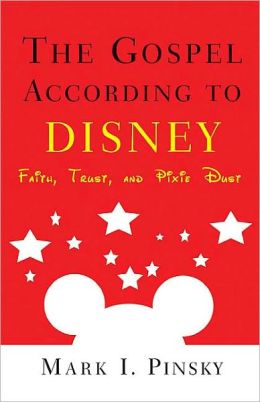The film Saving Mr. Banks has caused quite a buzz despite not being nominated for any major awards. This has centered around Walt Disney because for the first time, in the excellent portrayal by Tom Hanks, there was information about Disney’s past and his upbringing. While Disney enthusiasts have likely read the many books about the man, there was information the general public may not be aware of. One question that might be asked was if Disney was a religious man. Did he believe in God?
I was delighted to find this book at Asbury University in their Tree of Life bookstore, available for teachers and students seeking a seminary degree. Author and religion journalist Mark Pinsky has used an approach with Disney similar to what has been done with the media in the past. There are already Gospels according to Peanuts, Superman, Star Trek and many more. However Pinsky does not rely upon his own judgement and has gathered information from many religious leaders in regard to their opinion about the work of Disney. Pinsky tells us that in 1954 Time Magazine, in a cover story announced, “Measured by his social impact, Walt Disney is one of the most influential men in the world.” Doctor Robert Schuller would later reflect on Disney saying, “Gospel means good news. In the culture that comes from Judeo-Christian values, that is the theme: God will reward the right and will never reward the unrepentant wrong.”
Walt Disney was raised in an extremely strict church going home which made him not a fan of organized religion. However, he likely would agree that Christianity is a relationship with Jesus Christ and not a religion. Disney considered himself a religious man, but never belonged to a church. His faith in God never wavered and he wanted his films to reflect themes that were moral and ethical. He also believed greatly in prayer and wrote an article for Guideposts in 1964. He maintained, “….whatever success I have had in bringing clean, informative entertainment to people I attribute in great part to my Congregational upbringing and my lifelong habit of prayer.”
The author deals strictly with Disney’s animated films because he believes they have a consistent set of moral and human values based upon Judeo-Christian faith and principles. Faith is an essential element, faith in yourself and faith in something greater than yourself. Some thirty four animated feature films are examined by the author. Though cartoons are left out, a point is made that the classic character of Mickey Mouse is a perfectly innocent creature, like Adam before The Fall. There is no guile in him, he has not done anything sinful in his life and we all cheer for him because he is so good. John Updike described Mickey as “the most persistent and pervasive figure of popular culture” in the Twentieth Century.
We only have space to deal with a few of the films here and the one that set the tone was Walt Disney’s first animated feature, Snow White and the Seven Dwarfs. In this story there is a strong theme of sin and salvation When the film came out Reverend Charles Brashares of the First Methodist Church in Ann Arbor Michigan described Disney as a theologian and that the film was like “a reprint of the Scripture.” He compares Snow White to the innocent Eve of Eden who is tempted by evil to taste a poisoned apple. However she is raised back to life by the prince. To Brashares the evil queen was clearly Satanic.
Pinocchio is the favorite of most of the early Disney films. Though Disney would not use angels in his films, so as not to seem too doctrinal, fairies often took on that role like The Blue Fairy who gave instructions to the puppet about what must be done if he wished to become a real boy. Truthfulness was very important in proving himself. It is interesting that today some of the leading newspapers in America like to use the term Pinocchio for a mistruth and often award Pinocchios to people in government, Of course Pinocchio, after many misadventures due to misbehaving, is redeemed by the end of the film. He had to go through many trials before he would prove himself.
Often it is a matter of having faith as in the case of Dumbo who had what at first appears like a serious deformity. It was also a story of Mother Love being supreme. Many of the films had strong examples of characters being different and having to work to be accepted. There were also strong Christian themes in the cases of Snow White and Sleeping Beauty who among others found there is life after death. And the new life was much better than the lives they had experienced before.
I suspect this book may cause the reader to want to get those old classics, most still available on DVD and show them to their children and grandchildren. The book could be a good guide to use when watching the films, to discuss what messages may exist. Unlike Alfred Hitchcock who once put off a fan by saying, “It’s only a movie” for Disney these films were a great deal more. I would not go so far as one sermon by Michael Catlett in the McClean Baptist Church in McClean, Virginia which was titled, “Everything I needed to know I learned watching Disney.” However the films could be used as excellent teaching tools as long as we don’t get too pontifical which would kill the fun. There is a beautiful sense of wonder in Disney’s animated films which is something we should never want to outgrow.
The Gospel According to Disney is available at:





